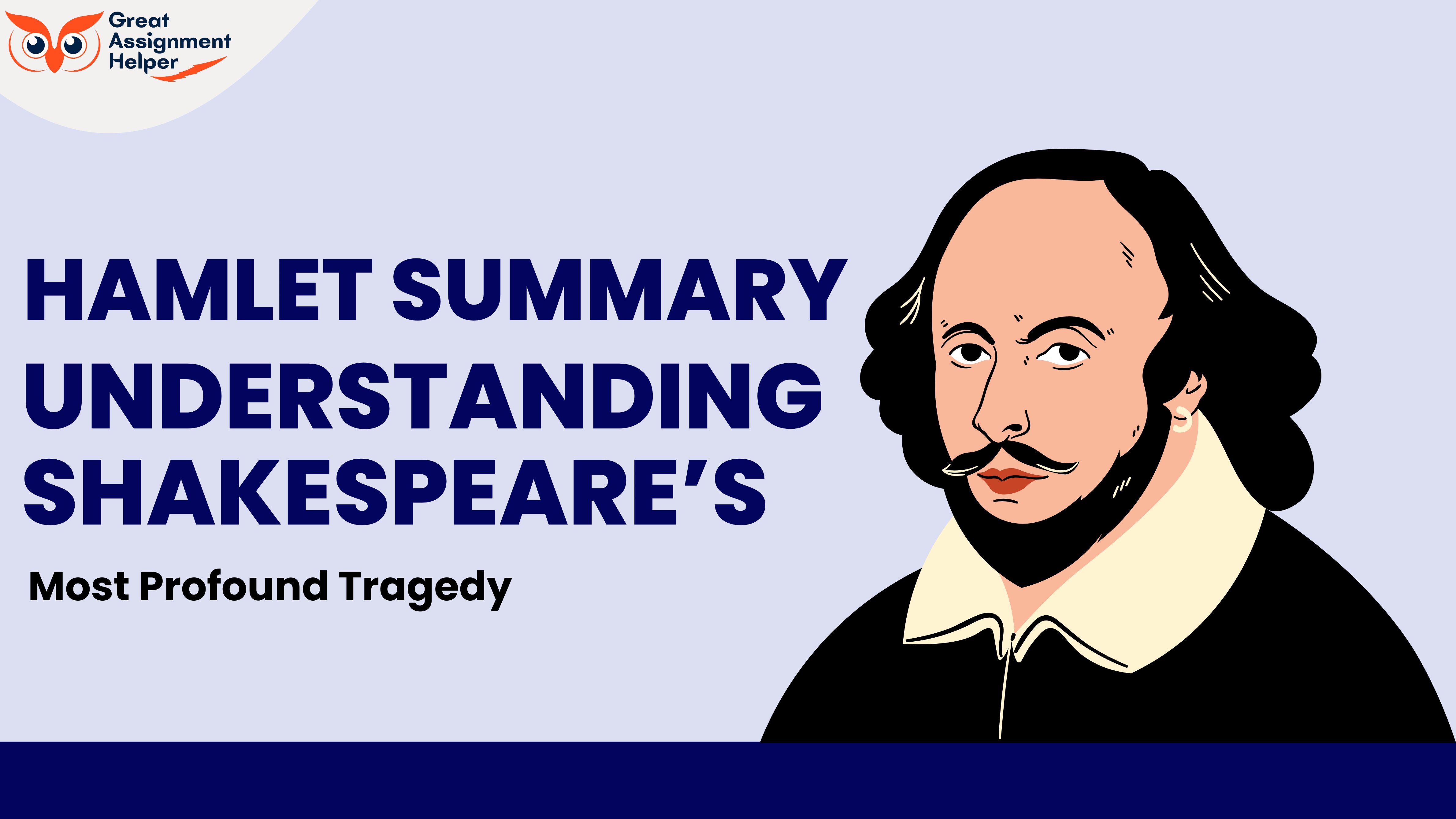
William Shakespeare’s Hamlet is arguably one of the most influential and widely studied works in English literature. This blog offers a comprehensive Hamlet summary, helping you understand the plot, themes, and psychological depth of the characters—especially the prince of Denmark, Hamlet. Whether you're a student, a literature enthusiast, or someone simply curious about the Hamlet play synopsis, this guide presents everything you need to know.
Listen To This Blog
What Is Hamlet About?
At its core, Hamlet is a tragedy about revenge, betrayal, madness, and political intrigue. The story begins in Denmark, where Prince Hamlet is devastated by the sudden death of his father, King Hamlet, and the swift remarriage of his mother, Queen Gertrude, to his uncle Claudius.
As the Hamlet plot unfolds, the young prince seeks the truth behind his father's death and grapples with intense internal conflict.
Hamlet Synopsis Short
A short summary of Hamlet would go like this: After the ghost of Hamlet's father reveals that Claudius murdered him to seize the throne, Hamlet vows revenge. However, his philosophical nature and moral doubts lead to delay and feigned madness. As the court unravels in deception, nearly every major character meets a tragic end.
Summary of Shakespeare's Hamlet
Here’s a more detailed summary of Hamlet to better grasp its complexity:
The Ghost Appears
The play opens on the battlements of Elsinore Castle. Guards see a ghost resembling the deceased king. They inform Prince Hamlet.
Revelation and Vow
The ghost confirms it is King Hamlet, claiming he was murdered by Claudius. He demands that Hamlet avenge his death.
Hamlet’s Madness
To uncover the truth and confuse his enemies, Hamlet pretends to be insane. This leads to court paranoia and mistrust.
The Play Within a Play
Hamlet stages a play reenacting his father's murder. Claudius’ disturbed reaction confirms his guilt.
Polonius’ Death
Mistaking him for Claudius, Hamlet kills Polonius, father of Ophelia and Laertes.
Ophelia's Madness and Death
Ophelia, devastated by her father's death and Hamlet's erratic behavior, descends into madness and drowns—accidentally or perhaps by suicide.
Laertes' Return
Laertes returns seeking revenge. Claudius manipulates him into a plot to kill Hamlet using a poisoned sword.
The Final Duel
During a duel between Laertes and Hamlet, Gertrude accidentally drinks poisoned wine. Laertes wounds Hamlet but is also injured. Claudius is killed by Hamlet. Hamlet dies shortly after, leaving Horatio to tell the story.
Hamlet Plot Summary
The plot summary of Hamlet reveals a complex narrative built on themes of hesitation, existential angst, and moral struggle. What separates Hamlet from other revenge tales is the internal conflict—is Hamlet insane or is he faking it? His constant questioning—of life, death, justice, and meaning—makes this tragedy a philosophical masterpiece.
Explanation of Hamlet
So what does it all mean? Here's an explanation of Hamlet that captures the essence of its depth.
Revenge and Justice
Hamlet’s pursuit of vengeance is more than personal; it reflects on the ethical implications of revenge.
Madness vs. Sanity
Is Hamlet truly mad? Or is it all a part of his elaborate ruse? Shakespeare blurs the line, challenging audiences to decide.
Corruption and Decay
Denmark is a "rotting" state, symbolized by lies, treachery, and moral compromise.
Existential Dread
The famous “To be or not to be” soliloquy shows Hamlet’s philosophical turmoil about life and suicide.
Analysis of Hamlet
An analysis of Hamlet must consider the complexity of its characters and the layered plot
Hamlet
is thoughtful, intelligent, and sensitive, yet indecisive and self-critical. His tragic flaw may be overthinking.
Claudius vis-à-vis King Hamlet
Claudius is a usurper driven by ambition and deceit, while the ghostly King Hamlet represents nobility and justice.
Gertrude
is a symbol of weakness and complicity, torn between loyalty to her son and her new husband.
Ophelia
reflects innocence destroyed by the machinations of men.
Laertes
serves as Hamlet’s foil—he acts swiftly and passionately, without moral introspection.
Hamlet Play Summary and Structure
The Hamlet play summary unfolds over five acts:
- Act I – Introduction, ghost revelation.
- Act II – Hamlet’s descent into “madness.”
- Act III – The play-within-the-play and confirmation of guilt.
- Act IV – Escalation: deaths of Polonius and Ophelia.
- Act V – The duel and mass tragedy.
This outline of Hamlet gives a glimpse of how Shakespeare structured his tragic masterpiece for emotional and philosophical impact.
Shakespeare Hamlet Summary: Why It Endures
The Shakespeare Hamlet summary isn't just a tale of revenge—it’s a psychological exploration of human flaws. Its timelessness comes from universal themes: betrayal, love, death, doubt, and the search for truth.
The play's lines “Something is rotten in the state of Denmark” and “To be or not to be” are iconic. Hamlet’s soliloquies offer a deep analysis of Hamlet’s psyche and confront the audience with the moral ambiguity of justice.
Hamlet Novel Summary vs Hamlet Play Synopsis
While often referred to as a novel, Hamlet is a play, but adaptations in prose form exist. The Hamlet novel summary tends to simplify the dialogue and monologues but retains the core narrative: a prince haunted by duty and doubt.
The Hamlet play synopsis, on the other hand, focuses more on stage directions, dialogues, and character interaction.
The Hamlet Drawing and Art Symbolism
Over centuries, Hamlet drawing and Hamlet draw contests have become popular among students and artists. These often depict Hamlet holding Yorick’s skull—symbolizing the theme of death and the fleeting nature of life.
The hamlet draw scenes visualize major moments like the ghost encounter, the play-within-the-play, or Ophelia’s tragic end.
Is Hamlet Insane?
One of the play’s most debated questions is: is Hamlet insane? While Hamlet admits to putting on an “antic disposition,” some of his actions—such as the erratic behavior toward Ophelia and the murder of Polonius suggest emotional instability.
However, scholars argue that Hamlet remains intellectually sharp and strategic throughout. His madness may be a coping mechanism or a deliberate tactic.
Hamlet Plot and Literary Devices
The Hamlet plot uses many literary techniques:
- Foreshadowing: The ghost’s appearance signals future turmoil.
- Irony: Claudius, the villain, acts piously.
- Symbolism: Yorick’s skull, poisoned wine, and Ophelia’s flowers each convey deeper meaning.
Also, Shakespeare draws thematic parallels between Hamlet and Macbeth’s fatal flaw—both protagonists are destroyed by internal weaknesses. While Macbeth’s is ambition, Hamlet’s is inaction.
Hamlet Story and Modern Relevance
The Hamlet story continues to resonate because its questions are timeless:
- What is the right way to avenge wrongdoing?
- Can justice be achieved without becoming unjust?
- How do grief and betrayal affect the human psyche?
In modern times, the play is studied in classrooms, performed in theaters, and even adapted into films and novels. The characters remain symbols of human emotion, moral conflict, and tragic flaws.
Hamlet Drawing and Student Engagement
Teachers and educators often encourage Hamlet drawing projects to enhance engagement. Students are asked to visually represent scenes, such as:
- The ghost’s confrontation with Hamlet.
- The famous graveyard scene.
- The duel in Act V.
These artistic interpretations deepen understanding of the Hamlet summary and help visualize character emotions and themes.
Conclusion: The Timeless Power of Hamlet
This comprehensive Hamlet summary highlights why Shakespeare’s tragedy remains unparalleled in its emotional and philosophical depth. Whether you're reviewing for school, revisiting a classic, or exploring the summary of Shakespeare’s Hamlet for the first time, understanding the prince’s journey offers insight into human nature itself. From its masterful dialogue to its layered characters and unforgettable Hamlet plot summary, the play teaches us about choice, consequence, and the haunting burden of truth. The explanation of Hamlet isn't just a study in revenge—it's a mirror into our deepest thoughts and fears. If you’ve ever wondered, what is Hamlet about, this guide should leave no doubt: it's about life, death, betrayal, madness, and the eternal struggle to find meaning.
For deeper insight into how students achieve success and the factors that influence outcomes, check out our detailed guide on understanding academic performance.

